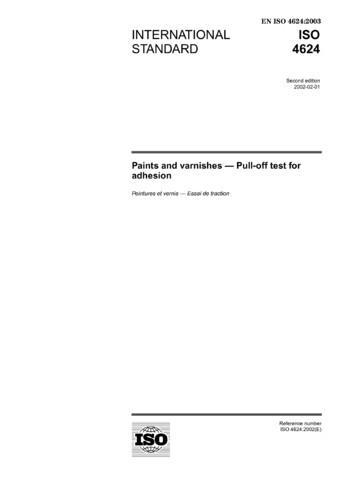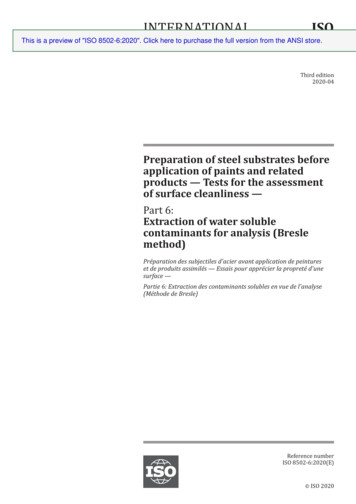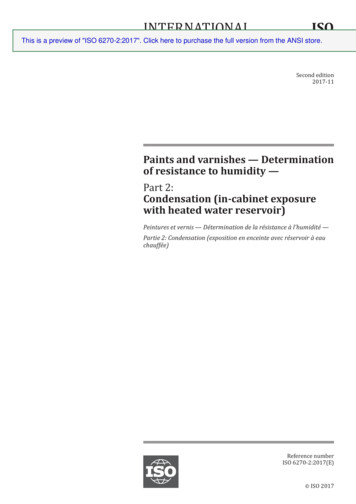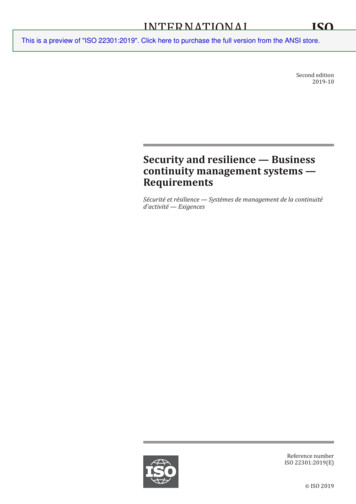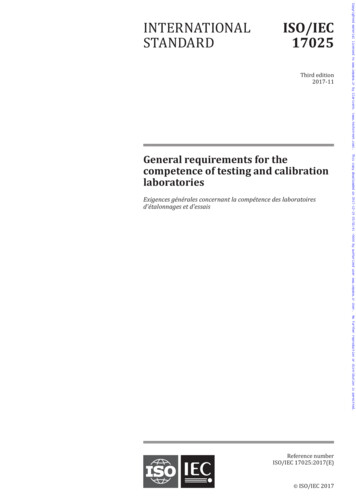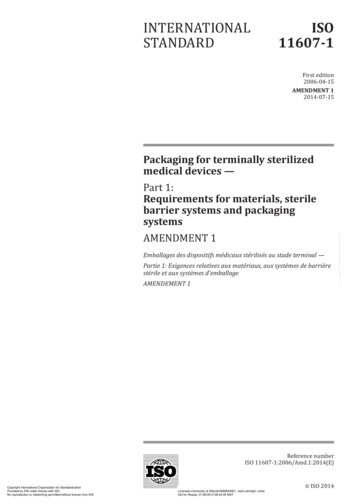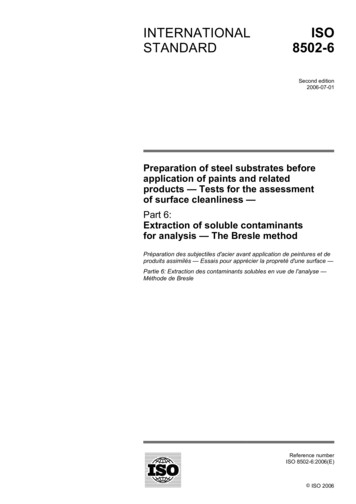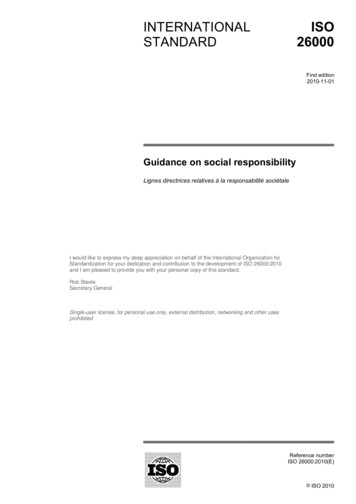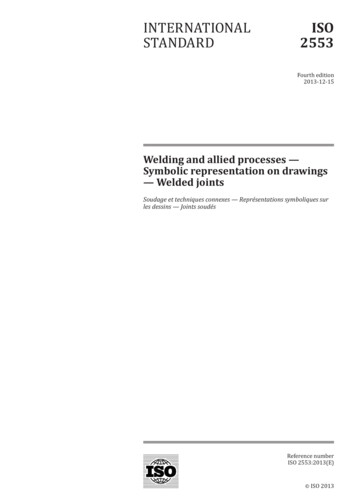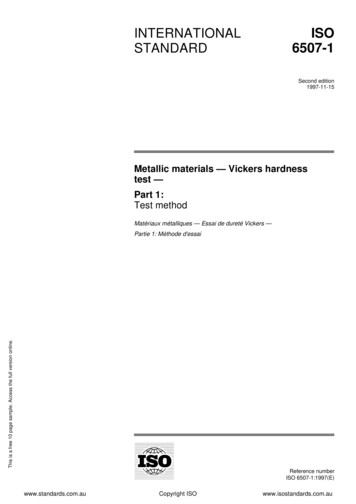
Transcription
ISO6507-1INTERNATIONALSTANDARDSecond edition1997-11-15Metallic materials — Vickers hardnesstest —Part 1:Test methodMatériaux métalliques — Essai de dureté Vickers —This is a free 10 page sample. Access the full version online.Partie 1: Méthode d'essaiAwww.standards.com.auCopyright ISOReference numberISO 6507-1:1997(E)www.isostandards.com.au
ISO 6507-1:1997(E)ContentsPage1Scope .12Normative reference .13Principle .24Symbols and designations .35Testing machine .36Test piece .47Procedure .48Uncertainty of the results .59Test report .6This is a free 10 page sample. Access the full version online.AnnexesAMinimum thickness of the test piece in relation to the test force and to the hardness .7BTables of correction factors for use in tests made on curved surfaces .9CTables of Vickers hardness values for use in tests made on flat surfaces .13DMonitoring the uncertainty of the testing machines by the users .107EBibliography .108 ISO 1997All rights reserved. Unless otherwise specified, no part of this publication may be reproducedor utilized in any form or by any means, electronic or mechanical, including photocopying andmicrofilm, without permission in writing from the publisher.International Organization for StandardizationCase postale 56 CH-1211 Genève 20 SwitzerlandInternet central@iso.chX.400c ch; a 400net; p iso; o isocs; s centralPrinted in Switzerlandiiwww.standards.com.auCopyright ISOwww.isostandards.com.au
ISOISO 6507-1:1997(E)ForewordISO (the International Organization for Standardization) is a worldwide federation of national standardsbodies (ISO member bodies). The work of preparing International Standards is normally carried outthrough ISO technical committees. Each member body interested in a subject for which a technicalcommittee has been established has the right to be represented on that committee. Internationalorganizations, governmental and non-governmental, in liaison with ISO, also take part in the work. ISOcollaborates closely with the International Electrotechnical Commission (IEC) on all matters ofelectrotechnical standardization.Draft International Standards adopted by the technical committees are circulated to the member bodiesfor voting. Publication as an International Standard requires approval by at least 75 % of the memberbodies casting a vote.International Standard ISO 6507-1 was prepared by Technical Committee ISO/TC 164, Mechanical testingof metals, Subcommittee SC 3, Hardness testing.This second edition of ISO 6507-1 cancels and replaces ISO 6507-1:1982, ISO 6507-2:1983,ISO 6507-3:1989, ISO 409-1:1982, ISO 409-2:1983 and ISO/DIS 409-3:1992 as follows:— Combination of the three different International Standards for the ranges of the test force(ISO 6507-1:1982, ISO 6507-2:1983, ISO 6507-3:1989) into this part of ISO 6507.— Integration of the tables for the calculation of Vickers hardness values for uses in tests madeon flat surfaces (ISO 409-1:1982, ISO 409-2:1983 and ISO/DIS 409-3:1992) as annex C of this part ofISO 6507.— The test method is specified for lengths of indentation diagonals between 0,020 mm and 1,400 mm.— If the difference between the lengths of the two indentation diagonals is greater than 5 %, this isstated in the test report.— Addition of a new clause 8 concerning the uncertainty of the test results.This is a free 10 page sample. Access the full version online.— Addition of a new informative annex D "Monitoring the uncertainty of the hardness testingmachines by the users".ISO 6507 consists of the following parts, under the general title Metallic materials — Vickers hardnesstest :— Part 1: Test method— Part 2: Verification of testing machines— Part 3: Calibration of reference blocksAnnexes A, B and C form an integral part of this part of ISO 6507. Annexes D and E are for informationonly.www.standards.com.auCopyright ISOiiiwww.isostandards.com.au
www.standards.com.auCopyright ISOwww.isostandards.com.auThis is a free 10 page sample. Access the full version online.
INTERNATIONAL STANDARD ISO 6507-1:1997(E)ISOMetallic materials — Vickers hardness test —Part 1:Test method1 ScopeThis part of ISO 6507 specifies the method of Vickers hardness test for the three different ranges oftest force for metallic materials (see table 1).Table 1Ranges of test force, FNF 49,031,961 F , 49,030,098 07 F , 1,961Hardness symbolPrevious designation(ISO 6507-1:1982) HV 5Vickers hardness testHV 0,2 to HV 5Low load Vickers hardness testHV 0,01 to HV 0,2Vickers microhardness testThe Vickers hardness test is specified in this part of ISO 6507 for lengths of indentation diagonalsbetween 0,020 mm and 1,400 mm.This is a free 10 page sample. Access the full version online.The force values in this part of ISO 6507 were calculated from kilogram force values. They wereintroduced before the SI-system was adopted. It was decided to keep the values based on the oldunits for this edition, but for the next revision it will be necessary to consider the advantage ofintroducing rounded values of test force and the consequence on the hardness scales.NOTE — In general, decreasing the test force increases the scatter of results of the measurements. This isparticularly true for low-force Vickers hardness tests and Vickers microhardness tests where the principallimitation will arise in the measurement of the diagonals of the indentation. For Vickers microhardness, theaccuracy of determination of the mean diagonal length is unlikely to be better than 0,001 mm (see annex E).For specific materials and/or products, particular International Standards exist.2 Normative referenceThe following standard contains provisions which, through reference in this text, constituteprovisions of this part of ISO 6507. At the time of publication, the edition indicated was valid. Allstandards are subject to revision, and parties to agreements based on this part of ISO 6507 areencouraged to investigate the possibility of applying the most recent edition of the standard indicatedbelow. Members of IEC and ISO maintain registers of currently valid International Standards.ISO 6507-2:1997, Metallic materials — Vickers hardness test — Part 2: Verification of testing machines.1www.standards.com.auCopyright ISOwww.isostandards.com.au
ISO 6507-1:1997(E) ISO3 PrincipleA diamond indenter in the form of a right pyramid with a square base and with a specified anglebetween opposite faces at the vertex is forced into the surface of a test piece followed bymeasurement of the diagonal length of the indentation left in the surface after removal of the testforce, F (see figure 1).This is a free 10 page sample. Access the full version online.Figure 1 — Principle of the testThe Vickers hardness is proportional to the quotient obtained by dividing the test force by the slopingarea of the indentation which is assumed to be a right pyramid with a square base, and having at thevertex the same angle as the indenter.2www.standards.com.auCopyright ISOwww.isostandards.com.au
ISOISO 6507-1:1997(E)4 Symbols and designations4.1 See table 2 and figure 1.Table 2SymbolDesignationaAngle between the opposite faces at the vertex of the pyramidal indenter(136 )FTest force, in newtonsdArithmetic mean, in millimeters, of the two diagonals length d1 and d2(see figure 1)Vickers hardness Constant HV 0,102NOTE Constant 1gn 19,806 65Test forceSurface area of indentation136 2 0,189 1 F2dd22 F sin 0,1024.2 The Vickers hardness is denoted by the symbol HV preceded by the hardness value followed bya) a number representing the test force (see table 3);b) the duration of loading, in seconds, if different from the time specified in 7.4.EXAMPLESThis is a free 10 page sample. Access the full version online.640 HV 30 Vickers hardness of 640 determined with a test force of 294,2 N applied for 10 s to 15 s.640 HV 30/20 Vickers hardness of 640 determined with a test force of 294,2 N applied for 20 s.5 Testing machine5.1 Testing machine, capable of applying a predetermined force or forces within the required rangeof test forces, in accordance with ISO 6507-2.5.2 Indenter, a diamond in the shape of a right pyramid with a square base, as specified in ISO 6507-2.5.3 Measuring device, as specified in ISO 6507-2.NOTE — A suggested procedure for monitoring the uncertainty of the hardness testing machine by the users isgiven in annex D.3www.standards.com.auCopyright ISOwww.isostandards.com.au
ISO 6507-1:1997(E) ISO6 Test piece6.1 The test shall be carried out on a surface which is smooth and even, free from oxide scale,foreign matter and, in particular, completely free from lubricants, unless otherwise specified inproduct standards. The finish of the surface shall permit accurate determination of the diagonallength of the indentation.6.2 Preparation shall be carried out in such a way that any alteration of the surface hardness, due toheat or cold-working, for example, is minimized.Due to the small depth of Vickers microhardness indentations, it is essential that special precautionsare taken during preparation. It is recommended to use a polishing/electropolishing process which issuitable for the material parameters.6.3 The thickness of the test piece or of the layer under test shall be at least 1,5 times the diagonallength of the indentation (see annex A).No deformation shall be visible at the back of the test piece after the test.6.4 For tests on curved surfaces, the corrections given in annex B, tables B.1 to B.6 shall be applied.6.5 For test pieces of small cross-section or of irregular shape, it may be necessary to provide someform of additional support.7 Procedure7.1 In general, the test is carried out at ambient temperature within the limits of 10 C to 35 C.Tests carried out under controlled conditions shall be made at a temperature of (23 5) C.7.2 The following test forces (see table 3) shall be used.Table 31)Hardness testThis is a free 10 page sample. Access the full version online.HardnesssymbolNominalvalue of thetest force FLow-force hardness testHardnesssymbolNominal valueof the testforce FN2)Microhardness testHardnesssymbolNNominalvalue of thetest force FNHV 549,03HV 0,21,961HV 0,010,098 07HV 1098,07HV 0,32,942HV 0,0150,147 1HV 20196,1HV 0,54,903HV 0,020,196 1HV 30294,2HV 19,807HV 0,0250,245 2HV 50490,3HV 219,61HV 0,050,490 3HV 100980,7HV 329,42HV 0,10,980 71) Nominal test forces greater than 980,7 N may be applied.2) The test forces for the microhardness test are recommended.4www.standards.com.auCopyright ISOwww.isostandards.com.au
ISOISO 6507-1:1997(E)7.3 The test piece shall be placed on a rigid support. The support surfaces shall be clean and freefrom foreign matter (scale, oil, dirt, etc.). It is important that the test piece lies firmly on the support sothat displacement cannot occur during the test.7.4 Bring the indenter into contact with the test surface and apply the test force in a directionperpendicular to the surface, without shock or vibration, until the applied force attains the specifiedvalue. The time from the initial application of the force until the full test force is reached shall not beless than 2 s nor greater than 8 s. For low-force hardness and microhardness tests, this time shall notexceed 10 s. For low-force hardness and microhardness tests, the approach speed of the indentershall not exceed 0,2 mm/s.The duration of the test force shall be 10 s to 15 s.For particular materials, a longer time for maintaining the force is provided; this time shall be appliedwith a tolerance of 2 s.7.5 Throughout the test, the testing machine shall be protected from shock or vibration.7.6 The distance between the centre of any indentation and the edge of the test piece shall be at least2,5 times the mean diagonal length of the indentation in the case of steel, copper and copper alloysand at least three times the mean diagonal length of the indentation in the case of light metals, leadand tin and their alloys.The distance between the centres of two adjacent indentations shall be at least three times the meandiagonal length of the indentation in the case of steel, copper and copper alloys, and at least six timesthe mean diagonal length in the case of light metals, lead and tin and their alloys. If two adjacentindentations differ in size, the spacing shall be based on the mean diagonal length of the largerindentation.7.7 Measure the lengths of the two diagonals. The arithmetical mean of the two readings shall betaken for the calculation of the Vickers hardness.For
International Standard ISO 6507-1 was prepared by Technical Committee ISO/TC 164, Mechanical testing of metals, Subcommittee SC 3, Hardness testing. This second edition of ISO 6507-1 cancels and replaces ISO 6507-1:1982, ISO 6507-2:1983, ISO 6507-3:1989, ISO 409-1:1982, ISO 409-2:1983 and ISO/DIS 409-3:1992 as follows:

